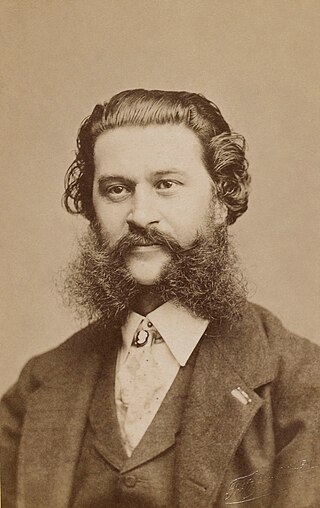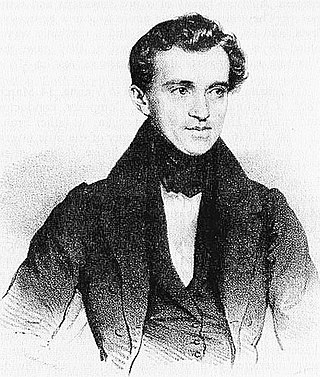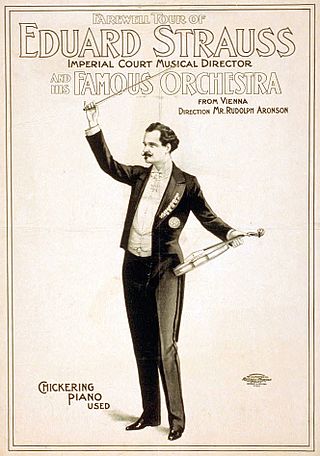Related Research Articles
Polka is a dance and genre of dance music originating in nineteenth-century Bohemia, now part of the Czech Republic. Though associated with Czech culture, polka is popular throughout Europe and the Americas.

Johann Baptist Strauss II, also known as Johann Strauss Jr., the Younger or the Son, was an Austrian composer of light music, particularly dance music and operettas as well as a violinist. He composed over 500 waltzes, polkas, quadrilles, and other types of dance music, as well as several operettas and a ballet. In his lifetime, he was known as "The Waltz King", and was largely responsible for the popularity of the waltz in Vienna during the 19th century. Some of Johann Strauss's most famous works include "The Blue Danube", "Kaiser-Walzer", "Tales from the Vienna Woods", "Frühlingsstimmen", and the "Tritsch-Tratsch-Polka". Among his operettas, Die Fledermaus and Der Zigeunerbaron are the best known.

Johann Baptist Strauss I, also known as Johann Strauss Sr., the Elder or the Father, was an Austrian composer of the Romantic Period. He was famous for his light music, namely waltzes, polkas, and galops, which he popularized alongside Joseph Lanner, thereby setting the foundations for his sons—Johann, Josef and Eduard—to carry on his musical dynasty. He is best known for his composition of the Radetzky March.

The Vienna New Year's Concert is an annual concert of classical music performed by the Vienna Philharmonic on the morning of New Year's Day in Vienna, Austria. The concert occurs at the Musikverein at 11:15. The orchestra performs the same concert programme on 30 December, 31 December, and 1 January but only the last concert is regularly broadcast on radio and television.

Josef Strauss was an Austrian composer.

Eduard "Edi" Strauss was an Austrian composer who, together with his brothers Johann Strauss II and Josef Strauss made up the Strauss musical dynasty. He was the son of Johann Strauss I and Maria Anna Streim. The family dominated the Viennese light music world for decades, creating many waltzes and polkas for many Austrian nobility as well as dance-music enthusiasts around Europe. He was affectionately known in his family as 'Edi'.

Johann Maria Eduard Strauss III was an Austrian composer whose father was Eduard Strauss, whose uncles were Johann Strauss II and Josef Strauss, and whose grandfather was Johann Strauss I. Born in Vienna, he was unofficially entrusted with the task of upholding his family's tradition after the dissolution of the Strauss Orchestra by his father in 1901. His talents were not fully realized during his lifetime as musical tastes had changed in the Silver Age with more popular composers such as Franz Lehár and Oscar Straus dominating the Viennese musical scene with their operettas, although his uncle, Johann Strauss II, supervised his development as a musician, a fact disputed by Eduard Strauss.

Joseph Franz Karl Lanner was an Austrian dance music composer and dance orchestra conductor. He is best remembered as one of the earliest Viennese composers to reform the waltz from a simple peasant dance to something that even the highest society could enjoy, either as an accompaniment to the dance, or for the music's own sake. He was just as famous as his friend and musical rival Johann Strauss I, who was better known outside of Austria in their day because of his concert tours abroad, in particular, to France and England.

Carl Michael Ziehrer was an Austrian composer. In his lifetime, he was one of the fiercest rivals of the Strauss family; most notably Johann Strauss II and Eduard Strauss.

Tritsch-Tratsch-Polka, Op. 214, is a polka in A major by Johann Strauss II, written in 1858 after a successful tour of Russia where he performed in the summer concert season at Pavlovsk, Saint Petersburg. It was first performed in a concert in Vienna on 24 November 1858.
Vom Donaustrande is a polka by Johann Strauss II written in 1873. Its themes are drawn from his successful operetta, Der Karneval in Rom which premiered in Vienna's Theater an der Wien on 1 March 1873.
Explosions-Polka, Op. 43, is a polka written by Johann Strauss II in 1847. The title was inspired by a discovery of guncotton or nitrocellulose by German scientist Christian Friedrich Schönbein in 1840. The Viennese press eagerly reported this discovery many years later in 1846, describing many products that can then be made 'explosive'.
'S gibt nur a Kaiserstadt, 's gibt nur a Wien! is a polka written by Johann Strauss II in 1864. The title of this polka was inspired from the waltz duet in the Singspiel Aline by Adolf Bäuerle with music by Wenzel Müller first performed at the Theater in der Leopoldstadt on 9 October 1822. The song titled 'Was macht denn der Prater' was a hit during its day whereas its refrain 'Ja nur ein' Kaiserstadt, ja nur a Wien' became a popular household phrase.
Im Krapfenwald'l op. 336 is a polka by Johann Strauss II written in 1869 and was originally titled 'Im Pawlowsk Walde' when first performed in Pavlovsk on 6 September 1869. Reportedly, several encores of the piece were called for and Strauss felt moved to retitled the piece to suit his audience back in native Vienna.
Vergnügungszug, op. 281 is a polka composed by Johann Strauss II in 1864. It was written for the Association of Industrial Societies' Ball held in the Redoutensaal on 19 January 1864 and was inspired by the opening of the Austrian Southern Railway – the Südbahn – which operated many 'pleasure trains' offering trips from Vienna to the countryside.

Cagliostro in Wien is an operetta in three acts by Johann Strauss II to a libretto by F. Zell and Richard Genée. It premiered on 27 February 1875 at the Theater an der Wien, featuring Marie Geistinger and Alexander Girardi.
Accelerationen (Accelerations), op. 234, is a waltz composed by Johann Strauss II in 1860 for the Engineering Students' Ball at the Sofienbad-Saal in Vienna. It is one of his best-known waltzes, famous especially for its rapidly accelerating opening waltz theme.
Waldine, Op. 385, is a polka-mazurka composed by Johann Strauss II. The title is taken from one of Strauss' operettas, Blindekuh. Waldine was the last, as well as the least successful, of the five orchestral dance compositions that Strauss had arranged on tunes from the operetta, having been first performed an entire year after the premiere of the operetta, where it was conducted by Eduard Strauss in the Musikverein in Vienna on December 7, 1879.
Champagner-Polka, Op. 211, subtitled "A musical joke", is a polka by Johann Strauss II, written in 1858 for his successful tour of Russia where he performed in the summer concert season at Pavlovsk, Saint Petersburg, where it was played for the first time on 12 August 1858.
References
Based on original text by Peter Kemp, The Johann Strauss Society of Great Britain. Used with permission.